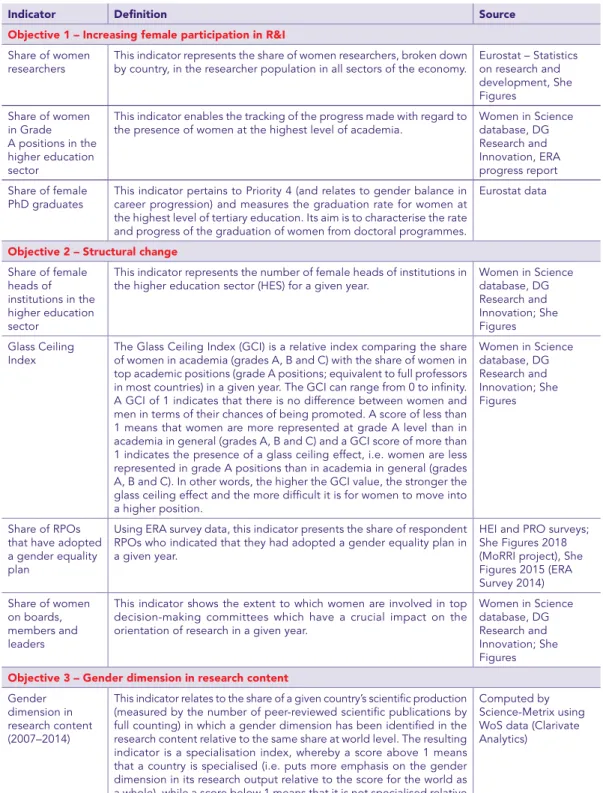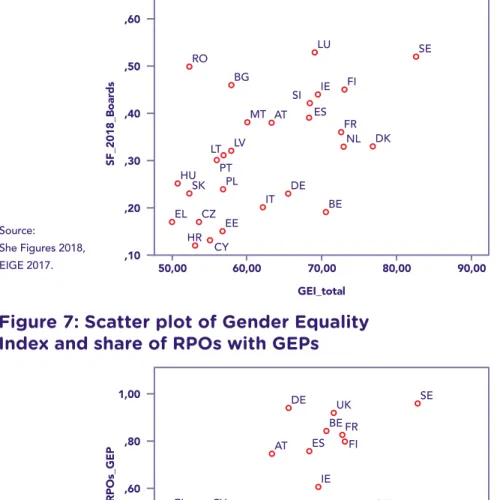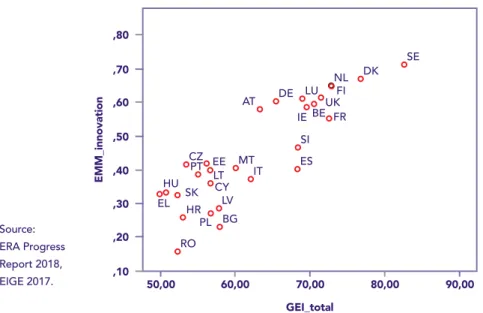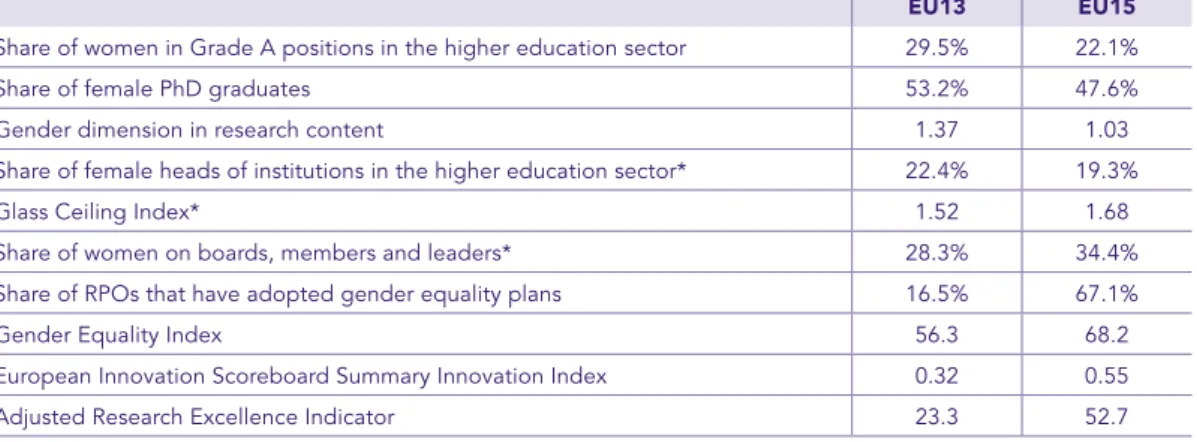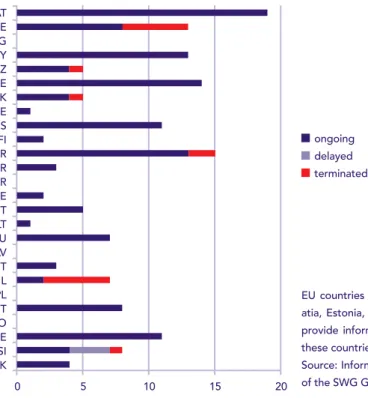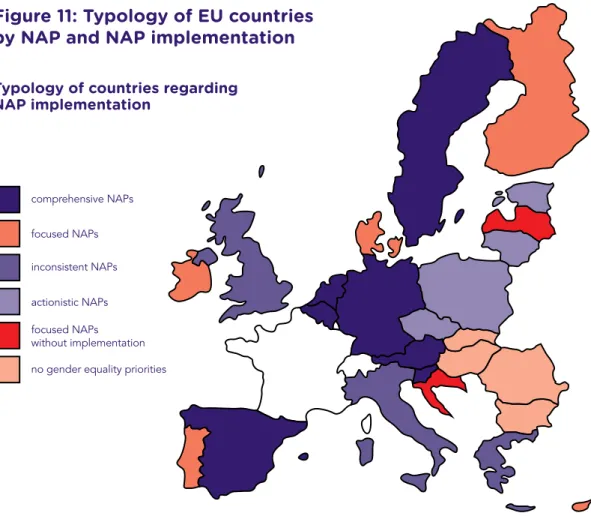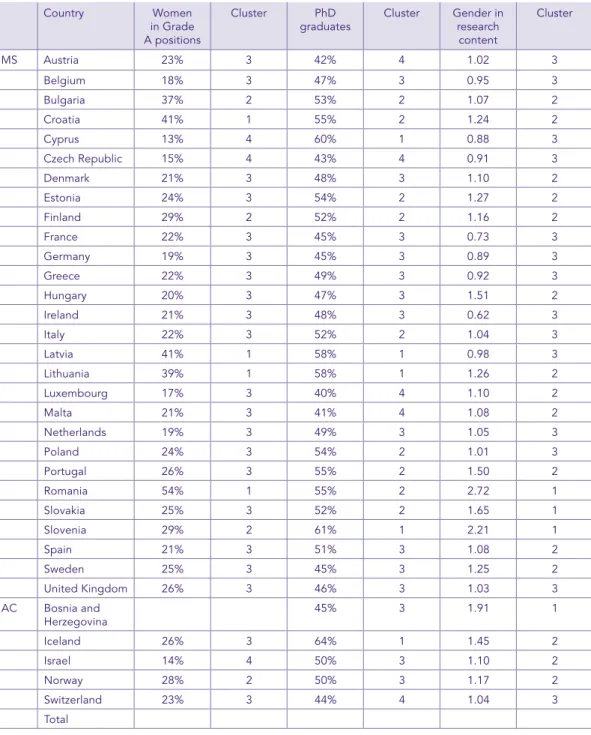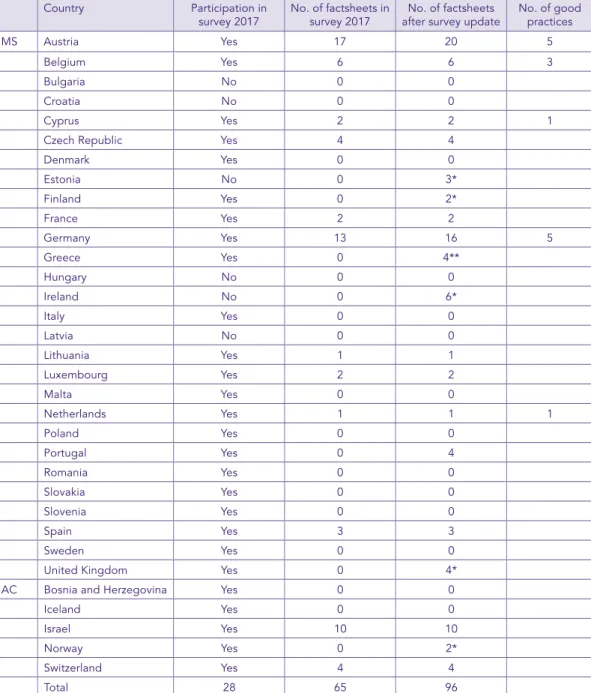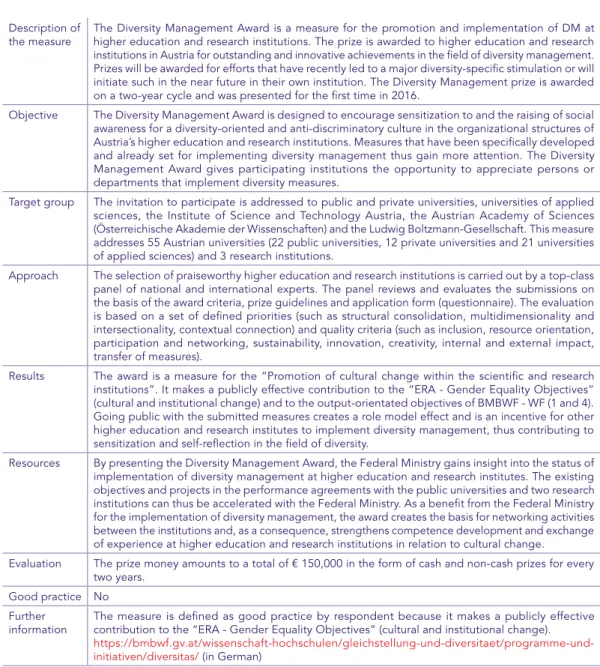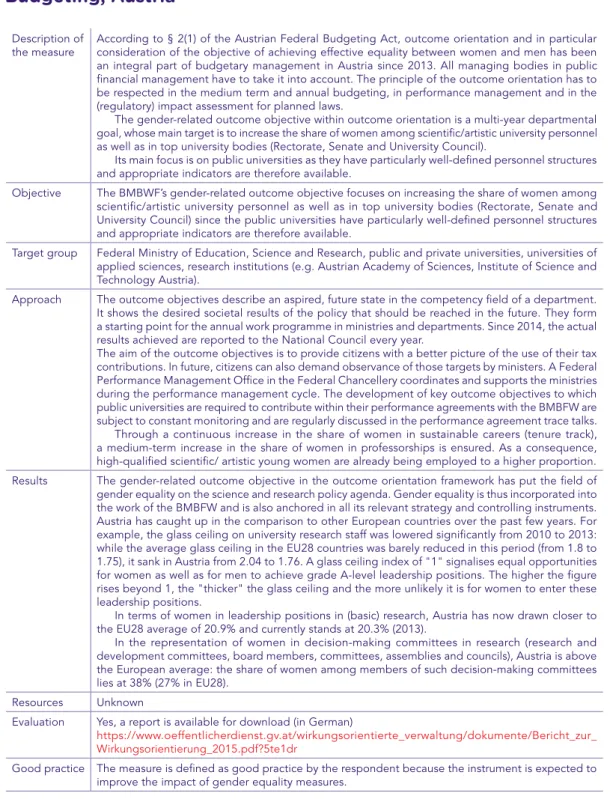Report
on Monitoring of ERA Priority 4
Implementation
Report on Monitoring of ERA Priority 4 Implementation
Angela Wroblewski
Institute of Sociology of the Czech Academy of Sciences
Prague, 2020
This project has received funding from the European Union’s Horizon 2020 research and innovation programme under grant agreement No. 741466.
Disclaimer — The views and opinions expressed in this document are solely those of the project, not those of the
Deliverable 3.2 (D 5) has been prepared as part of Work Package 3 led by Roberta Schaller-Steidl, Federal Ministry for Education, Science and Research, Austria, and task leader Angela Wroblewski, Institute for Advanced Studies, Austria.
For more information about monitoring of ERA
Priority 4 implementation, please contact us
at info@genderaction.eu
Table of Contents
Executive Summary 6
Abbreviations 8
1. Introduction 10
2. Gender Equality in the European Research Area 12
3. Monitoring of Priority 4 15
3.1 GENDERACTION approach to monitoring 15
3.2 Proposed set of indicators 18
4. State of implementation regarding Priority 4 21 4.1 State of implementation of Priority 4 based
on aggregate indicators 21
4.2 Differences between EU15 and EU13 countries 30 5. Implementation of ERA Priority 4 31 5.1 Analysis based on NAP documents 31 5.2 Analysis based on the adapted progress tool 34 5.3 Good practice policies and measures 35
6. Concluding Assessment 42
7. Stakeholders’ perspective on NAP 44 7.1 Assessment of NAP implementation 44 7.2 Assessment of the NAP process 47
8. Conclusions 49
8.1 Summary of the main results 49
8.2 Recommendations 51
9. References 54
9.1 Documents used 56
10. Annex 61
10.1 Expert interviews 61
10.2 ERA Monitoring indicators 64
10.3 Number of policies or measures implemented
in the context of the NAP 65
10.4 Description of good practices 66
Report on Monitoring of ERA Priority 4 Implementation / Table of Contents
Executive Summary
The second report of GENDERACTION WP3 builds on the results of the first report on NAP implementation (D3.1) which showed that differ- ent countries take different approaches to NAPs and that the level of implementation of gender equality policies differs from country to country.
Furthermore, NAPs differ regarding the concept of gender equality used. The analysis also identifies differences between EU15 countries and newer EU Member States (EU13 countries which joined the EU from 2004 onwards) regarding their experience with the development of NAPs and their gender equality policies.
The present report draws on multiple data sources (results from an analysis of NAP docu- ments, an online survey conducted in 2017 and an update of the survey in early 2019, interviews with members of the Standing Working Group on Gender in R&I) and pursues a threefold aim:
1) to provide a set of indicators for monitoring NAP implementation,
2) to assess NAP implementation based on these indicators, and
3) to formulate recommendations for the next pe- riod of ERA implementation.
Our analysis shows that 26 of the 28 EU Member
(NAP). For several countries, the ERA Roadmap was the initial spark that triggered the develop- ment of their first-ever gender equality strategy for R&I (e.g. Cyprus, Luxembourg, Malta or Norway).
In others, the NAP was used to consolidate and further develop existing policies which support gender equality in R&I. Member States had con- siderable scope when it came to developing a NAP within the framework of the ERA Roadmap. This allowed the NAPs to be aligned with the actual circumstances in each country (e.g. by addressing specific gender inequalities, building on existing experience with gender equality policies and in- volving relevant national stakeholders).
We used all the information collected to develop a typology of countries with respect to NAPs and NAP implementation. We distinguish therein between six clusters of countries:
• Countries with a comprehensive and consist- ent NAP and corresponding implementation (Austria, Belgium, Germany, the Netherlands, Slovenia, Spain and Sweden)
• Countries with focused NAPs (Cyprus, Den- mark, Finland, Ireland, Luxembourg, Malta and Portugal) which address two out of three ERA gender equality objectives
• Countries with inconsistencies within the NAP
The European Research Area (ERA) Priority 4 focuses on gender equality and
gender mainstreaming in research and innovation. The objective is to foster
scientific excellence and breadth of research approaches by fully utilising gender
diversity and equality and avoiding an indefensible waste of talent. Within their
National Action Plans (NAPs), European Union Member States and Associated
Countries are asked to develop policies which address gender imbalances,
particularly at senior levels and in decision making, and which strengthen the
gender dimension in research. The aim of GENDERACTION Work Package 3 (WP3)
is to analyse the implementation of Priority 4 in NAPs, identify good practices and
develop recommendations for the next ERA Roadmap as well as its monitoring
of gender equality. The results of WP3 will inform and feed into the work of WP4
Mutual Learning and Capacity Building Activities and WP5 Policy Advice.
Report on Monitoring of ERA Priority 4 Implementation / Executive Summary
• Countries with actionistic NAPs (the Czech Republic, Estonia, Lithuania and Poland) which do not contain a context analysis but formulate priorities and/or implement measures
• Countries with focused NAPs but without im- plementation (Croatia and Latvia)
• Countries without a NAP (Hungary and Slova- kia) or with a NAP but without gender equali- ty priorities (Bulgaria and Romania).
It is striking that the cluster of countries which the GENDERACTION assessment categorises as good practice countries with regard to NAP Priority 4 implementation differs significantly from the coun- tries identified as the leading group in the ERA Progress Report 2018 (EC 2019a). According to this report, Croatia, Lithuania, Latvia and Romania belong to Cluster 1, which contains the best-per- forming countries in terms of the share of women in Grade A positions. However, our analysis iden- tified Austria, Belgium, Germany, the Netherlands, Slovenia, Spain and Sweden as the countries with comprehensive and consistent NAPs.
This difference in assessment results from dif- ferent approaches to gender equality and cor- respondingly, from different indicators used to measure the implementation of gender equality policies. While the GENDERACTION assessment focuses on the implementation process of gender equality policies based on multiple data sources and indicators, the ERA progress report focuses on the development of the headline indicator and two supporting indicators. This approach is too limited to provide meaningful information for the assessment of progress towards gender equality in R&I.
Experiences with the NAP implementation and the results achieved so far show the potential of the instrument to initiate (further) development of gender equality policies. However, it is also evi- dent that the process linked to the ERA Roadm- ap development, implementation and monitoring does not provide incentives to increase engage- ment regarding gender equality in R&I for coun- tries that are relatively inactive. Consequently, the gap between experienced and inactive countries with regard to gender equality in R&I is widening.
Our recommendations focus on three areas and aim at supporting a more coherent gender equality policy in R&I. (1) Experiences with the
NAPs 2015-2020 indicate a need for an adapta- tion of the NAP development and submission procedure, including the provision of more de- tailed guidance for NAP development, the in- volvement of relevant national stakeholders and the consideration of gender equality in other ERA priorities. (2) The analysis of NAP implementation produces results which are not in line with the ERA progress report as the countries identified as top performers by these approaches differ. Hence, a meaningful set of indicators for monitoring NAP implementation needs to be developed.
GENDERACTION suggests a combined approach using quantitative (available) indicators and qual- itative/survey data provided by the countries. (3) The varying goals and focus of gender equali- ty policies presented in NAPs indicate a lack of a gender equality discourse. We recommend us- ing the NAP development, implementation and monitoring processes for consolidating a gender equality discourse for R&I in the EU. This discourse should aim at establishing a shared understand- ing of gender equality and common goals at the EC and MS level. This common understanding of gender equality and its goals is the basis for mu- tual learning.
Another important aspect of a gender equal- ity discourse is to stress the positive relationship between gender equality on the one hand and innovation and excellence on the other hand. The analysis shows no positive correlation between the share of women in Grade A and the innovation and excellence indicators. But the higher a coun- try scores on the Gender Equality Index, the high- er its innovation potential. Similarly, the correla- tion between the share of RPOs with GEPs and the innovation indicators are significant and positive.
This means that an increasing share of RPOs with
GEPs is positively correlated with a countries’ in-
novation potential. The upcoming discussion of
major societal challenges – from the European as
well as the global perspectives – should explicitly
address this link.
AC: Associated Countries, countries associated to Horizon 2020 ARES: Académie de recherche et d'enseignement supérieur (Belgium) AT: Austria
BE: Belgium BG: Bulgaria
BMBFW: Federal Ministry of Education, Science and Research (Austria) CODE_IWP: Commitment to Democracy through Increasing
Women’s Participation (Cyprus)
CY: Cyprus
CZ: The Czech Republic
DE: Germany
DFG: German Research Foundation (Germany)
DK: Denmark
DM: Diversity Management EC: European Commission
ECTS: European Credit Transfer and Accumulation System EE: Estonia
EL: Greece
EMM: European Monitoring Mechanism ERA: European Research Area
ES: Spain
EU: European Union
EU13: Member States which joined the EU from 2004 onwards
(Bulgaria, Croatia, Cyprus, the Czech Republic, Estonia, Hungary, Latvia, Lithuania, Malta, Poland, Romania, Slovakia and Slovenia).
EU15: Member States which joined the EU by 1995 at the latest (Austria, Belgium, Denmark, Finland, France, Greece, Germany, Ireland, Italy, Luxembourg, the Netherlands, Portugal, Spain, Sweden, the United Kingdom)
FI: Finland
FR: France
FWB: Fédération Wallonie-Bruxelles (Belgium) GCI: Glass Ceiling Index
GE: Gender Equality GEP: Gender Equality Plan
GPC: High Level Group for Joint Programming H2020: Horizon 2020, EU funding scheme HEI: Higher Education Institution HES: Higher Education Sector
HG: Helsinki Group (predecessor of SWG GRI) HR: Human Resources
Abbreviations
Report on Monitoring of ERA Priority 4 Implementation / List of Abbreviations
HR: Croatia
HRS4R: Human Resources Strategy for Researchers HU: Hungary
IE: Ireland IT: Italy
JUST: Directorate-General for Justice and Consumers (European Commission)
LT: Lithuania LU: Luxembourg LV: Latvia
MINT: Mathematics, Informatics, Natural Sciences and Technology
MT: Malta
MS: Member States NAP: National Action Plan NL: The Netherlands
NWO: Dutch Research Council (Netherlands)
OMCI: Observatory for Women, Science and Innovation (Spain) OTM-R: Open, Transparent, Merit-based Recruitment
PL: Poland
PSF: Policy Support Facility PT: Portugal
RFO: Research Funding Organisation R&I: Research and Innovation RO: Romania
RPO: Research Performing Organisation
SE: Sweden
SFIC: Strategic Forum for international S&T Cooperation Sl: Slovenia
SK: Slovakia
S&T: Science and Technology
STEM: Science, Technology, Engineering and Mathematics
SWG GRI: Standing Working Group on Gender in Research and Innovation UK: The United Kingdom
UNESCO: United Nations Educational, Scientific and Cultural Organization UNITWIN: University Twinning and Networking Programme (UNESCO) VSNU: Dutch Association of Universities
WLB: Work-Life Balance
w-fFORTE: Economic impulses by women in research and technology (Austria)
WP: Work Package
Introduction
1
1 For purposes of readability, we will refer to these in the remainder of this report simply as National Action
The European Research Area (ERA) Priority 4 focus- es on gender equality and gender mainstreaming in research and innovation. The objective is to foster scientific excellence and breadth of research approaches by fully utilising gender diversity and equality and avoiding an indefensible waste of talent. Within their National Action Plans (NAPs), European Union Member States are asked to de- velop policies which address gender imbalances particularly at senior levels and in decision making and which strengthen the gender dimension in research. Member States and Associated Coun- tries should initiate gender equality policies in research performing organisations (RPOs) and re- search funding organisations (RFOs). They should also monitor the effectiveness of such policies on a regular basis and adjust measures as necessary.
The aim of GENDERACTION Work Package 3 (WP3) is to benchmark the implementation of Pri- ority 4 in national ERA roadmaps or NAPs
1. WP3 focuses on identifying best practices in national legal and policy environments which support pro- gress towards achieving Priority 4. The results of WP3 will inform and feed into the work of WP4
The first WP3 (D3.1) report showed that differ- ent countries take different approaches to NAPs and that the level of implementation of gender equality policies differs from country to country.
While some countries describe their full gender
equality policy mix in their NAPs, others restrict
their description to the current focus of their gen-
der equality policy or a process to further devel-
op the existing policy mix. At the other end of
the spectrum are countries which only formulate
a general commitment to gender equality or do
not even address it at all in their NAPs. Further-
more, NAPs differ regarding the concept of gen-
der equality used. While some countries address
all three ERA gender equality objectives (increas-
ing the share of women in all fields and hierar-
chical levels of R&I; structural change to abolish
barriers for women’s careers; integration of the
gender dimension in research content and teach-
ing), others only focus on one or two. An online
Report on Monitoring of ERA Priority 4 Implementation / 1. Introduction 2 The other two questions were “What is missing in the
progress tool to give a comprehensive picture of NAP implementation in your country?” and “What would you see as the main development regarding gender in R&I in your country since 2016?”. 12 out of 30 ERA countries provided information before or after the meeting.
survey revealed differences between EU15 coun- tries and newer Member States (EU13 countries which joined the EU from 2004 onwards) in sev- eral respects. For 57% of newer Member States the NAP was the first policy document on gender equality in R&I, a fact that only holds for 25% of EU15 countries. Priority 4 is more likely to be in- terlinked with other priorities in EU15 countries (39% versus 14%). EU13 countries refer more fre- quently to difficulties regarding the development of Priority 4.
The second report in GENDERACTION WP3 builds on the results of the first report on NAP im- plementation (D3.1) and pursues a threefold aim:
1) to provide a set of indicators for monitoring NAP implementation,
2) to assess NAP implementation based on these indicators, and
3) to formulate recommendations for the next pe- riod of ERA implementation.
The analysis is based on multiple data sources which complement each other:
The starting point for GENDERACTION was a document analysis – in most cases, the NAPs.
A list of documents included in the analysis is pro- vided in chapter 9.1.
In autumn 2017, an online survey on NAP de- velopment and implementation was carried out among members of the Standing Working Group on Gender in Research and Innovation (SWG GRI).
The results of this survey are provided in D3.1.
In early 2019, the survey was updated using the
“Progress Tool” developed by the GPC Task Force for the analysis of the implementation of Priority 2a. Members of the SWG GRI received a short e-mail questionnaire and the progress tool adapt- ed for Priority 4 measures. A total of 21 countries provided information on the current state of their NAP implementation.
To complement the available data, the SWG GRI agreed that GENDERACTION WP3 could con- duct expert interviews with its members regarding NAP development and implementation. In prepa- ration for a meeting of the SWG GRI in April 2019 in Brussels, three preliminary questions were sent to its members, one of which asked if they would agree to participate in an interview.
2Representa- tives of 12 countries agreed to do so. They were all subsequently contacted, and in the end, nine inter-
views were carried out from May to July 2019 (see Appendix 10.1.3 for a list of interviewees).
The second report on NAP implementation starts with a description of the ERA process and the manner in which gender equality is addressed in different phases of ERA development (Chapter 2).
In a next step, the GENDERACTION approach to
monitoring and the set of indicators used to assess
NAP implementation is presented (Chapter 3). The
Priority 4 implementation status is then analysed
using indicators referred to in the ERA progress re-
ports (Chapter 4). This is followed by an analysis of
NAP implementation based on the data collected
in GENDERACTION (Chapter 5). Expert interviews
conducted with stakeholders involved in NAP im-
plementation complete the picture indicated by
the survey data, aggregate data (e.g. She Figures)
and relevant documents (Chapter 7). Finally, the
main results are summarised and used as the ba-
sis for the formulation of recommendations for the
next ERA Roadmap (Chapter 8).
Gender Equality in the European Research Area
2
The political concept of the European Research Area (ERA) was first launched in 2000 with the publication of the European Commission’s “To- wards a European Research Area” Communication (EC 2000). The main objectives of this initiative were to boost Europe's competitiveness, to im- prove the coordination of research activities on both a national and a European level, to develop human resources and to increase the attractive- ness of European research to the best research- ers from all over the world. The EU’s Framework Programme for Research, Technological Develop- ment and Demonstration was considered to be the most important instrument for the implemen- tation of the European Research Area.
In 2007, progress in the development of the ERA was assessed and new perspectives pre- sented in the form of a Green Paper (EC 2007).
The Green Paper underlines the importance of ERA for the European Union to become a lead- ing knowledge society. It also confirms the main ERA objectives. “The ERA concept encompasses three inter-related aspects: a European ‘internal
European-level coordination of national and re- gional research activities, programmes and poli- cies; and initiatives implemented and funded at European level” (EC 2007: 5). In December 2008, the Competitiveness Council formulated a 2020 Vision for the European Research Area which was endorsed by the European Council (Council of the European Union 2008). The outlined vision of the ERA is based on six dimensions, namely:
realising a single labour market for researchers;
developing world-class research infrastructures;
strengthening research institutions; sharing knowledge; optimising research programmes and priorities; and opening to the world through international cooperation in science and technol- ogy (S&T).
A third phase in the development of the ERA
began in 2012 with the new Communication and
Council Conclusions (EC 2012), which led to the
adoption of the ERA Roadmap 2015-2020 (ERAC
2015). The purpose of this roadmap is to identify
a limited number of top priority actions that will
have the biggest impact on Europe's research
Europe have different characteristics and specifi- cities. It is up to the Member States to specify the strategies and actions for taking ERA further at the national level that are best suited to the struc- tures and dynamics of their national research and innovation systems (Council of Europe 2015: 3).
The ERA Roadmap also makes provisions for monitoring in conjunction with ERA Progress Re- ports. This monitoring should be kept as lean as possible to avoid additional administrative bur- dens yet also be clear and workable at both na- tional and EU level.
The ERA Roadmap defines six priorities for policies to build ERA at the national level:
• Priority 1 – Effective national research systems
• Priority 2a – Jointly addressing grand chal- lenges
• Priority 2b – Making optimal use of public in- vestments in research infrastructure
• Priority 3 – An open labour market for re- searchers
• Priority 4 – Gender equality and gender main- streaming in research
• Priority 5 – Optimal circulation and transfer of scientific knowledge
• Priority 6 – International cooperation.
The gender dimension in science and research has been addressed in several ways in this pro- cess. For instance, the Communication “Towards a European Research Area” explicitly addresses the underrepresentation of women “There are not enough women in research in Europe” (EC 2000: 17). The need for action to increase the share of women in science and research is justified by the leaky pipeline phenomenon (decreasing female participation in science compared to the share of women among graduates) as well as dis- criminatory mechanisms and their anticipation by women. The Communication also refers to the EC Communication “Women in Science” (EC 1999), a policy document which formulates the aim to
“encourage women to take part in European re- search” (EC 1999: 3). The European Commission (EC) already envisaged the development of a co- herent approach to increase the share of women in its Fifth Framework Programme (FP5), which included the Marie Curie scholarships as well as corresponding advisory groups and assessment/
monitoring panels aimed specifically at promoting
Report on Monitoring of ERA Priority 4 Implementation / 2. Gender Equality in the European Research Arearesearch by, for and on women. In other words, its goal was not only to increase female participation in research but also to strengthen gender issues in research content (“research for women” and
“research on women”).
The aforementioned Green Paper also calls for initiatives to increase the share of women in science and research. “It is thus essential to establish a single and open European labour market for researchers, ensuring effective ‘brain circulation’ within Europe and with partner coun- tries and attracting young talent and women into research careers.” (EC 2007: 11) In contrast to the EC Communication “Women in Science”
(EC 1999), the Green Paper does not address the gender dimension in research content.
In the third phase of the development of the ERA (see, e.g., EC 2012; Council of Europe 2012), the focus of the gender dimension in the ERA is widened and formulated more explicitly.
Gender equality and gender mainstreaming in research are defined as one of six ERA priorities
“to end the waste of talent which we cannot af- ford and to diversify views and approaches in research and foster excellence” (EC 2012: 4). Pri- ority 4 now defines three dimensions of gender equality: (1) the representation of women in sci- ence in general, (2) the representation of women in decision-making positions as well as structural and cultural barriers which lead to an underrep- resentation of women in decision making, and (3) the integration of gender in research content. In the years that have since followed, the Europe- an Commission and the Council of Europe refer to this definition of gender equality – e.g. in the Council’s conclusions on the European Research Area Roadmap (2015) or in the recent ERA Pro- gress Report (EC 2019).
The European Research Area and Innovation
Committee (ERAC) is a main actor in the ERA
context. ERAC is a strategic policy advisory com-
mittee that advises the Council, the Commission
and Member States on the full spectrum of re-
search and innovation issues in the framework
of the governance of the European Research
Area. Its mandate was decided by the Council
in October 2015. The Committee is co-chaired
by the Commission and an elected representa-
tive from a Member State. The Council provides
its secretariat. ERAC members are the European
Commission and the EU Member States. Non-EU countries which are associated to EU research and innovation programmes may participate as observers in its activities.
3ERAC currently has three Standing Working Groups: Open Science and Innovation, Human Resources and Mobility, and Gender in Research and Innovation. The Committee can also meet in two dedicated configurations, which were es- tablished by the Council and are chaired by an elected representative of an EU Member State:
(1) the High Level Group on Joint Programming (GPC), which contributes to the preparation of the debates and decisions of the Competitive- ness Council on joint programming and (2) the Strategic Forum for International S&T Cooper- ation (SFIC), which advices the Council and the Commission on the implementation of a Europe- an Partnership in the field of international scien- tific and technological cooperation.
In the following, we will focus on the ques- tion of how gender equality is considered by the Member States when implementing the ERA Roadmap. Our analysis is based on key ERA documents at European and national level, a survey of national stakeholders involved in the development and implementation of the nation- al ERA Roadmaps or NAPs as well as a series of interviews with experts. It is also based on the assumption that sustainable gender equality pol- icies in the ERA require a shared understanding by all stakeholders involved in NAP implemen- tation of the problem to be addressed and the main objectives. Such a common understanding is the result of a discursive process. Vice versa, the lack of a common definition of problems and objectives can be interpreted as a lack of a dis- course. We understand discourse to be “themat- ically connected and problem-related semiotic (for example oral or written) occurrences that relate to specific semiotic types, which serve par- ticular political functions” (Reisigl 2008: 99; see also Wodak 2008). Hence, we start from the posi- tion that problems are not given but rather social constructs (see Bacchi 2009).
Applied to our context, this means that “gen- der mainstreaming”, “gender analysis” and
“gender equality” are discursively construct-
with regard to the way the problem of gender inequality is presented and which solutions are proposed (Bacchi 2000). This is why we focus in our analysis of the implementation of NAPs on how the gender equality problem has been rep- resented in policy making (both in documents and policies).
3 The following countries currently have observer sta- tus: Albania, Armenia, Bosnia and Herzegovina, Faroe Islands, North Macedonia, Georgia, Iceland, Israel,
Monitoring of Priority 4
3
Before we go on to present the results of our empirical analysis, we first outline the GENDER- ACTION approach to monitoring as well as the proposed set of indicators for monitoring the im- plementation of ERA Priority 4.
next steps are to design and implement measures to achieve the desired objectives. The implementa- tion of these measures should constantly be moni- tored. Ideally, this monitoring should be accompa- nied by an evaluation of the measures – either in parallel with the implementation to identify starting points for further development of the measures or ex-post to measure their effectiveness.
For this report, we define monitoring in line with the definition proposed by Markiewicz and Patrick (2016: 12) as: “the planned, continuous and systematic collection and analysis of program information able to provide management and key stakeholders with an indication of the extent of progress in implementation, and in relation to program performance against stated objectives and expectations.”
43.1
GENDERACTION approach to
monitoring
As already discussed in our first report on national roadmaps and mechanisms in ERA Priority 4 (D3.1), we assume that efficient and effective gender equality policies are developed and implemented following a complete policy cycle (May, Wildavsky 1978; Bergmann, Pimminger 2004).
This implies that gender equality policy objec- tives and priorities must be formulated based on an analysis of the status quo with regard to the three gender equality dimensions (gender analysis). The
4 This does not include a systematic determination of the quality and value of the policies or measures im- plemented or their contribution to the achievement of goals and objectives, which would be the task of an evaluation. Report on Monitoring of ERA Priority 4 Implementation / 3. Monitoring of Priority 4
3.1.1 Purpose of monitoring
Continuous monitoring generally pursues four goals which together support the efficient use of resources:
• Monitoring should provide an overview of cur- rent developments in the context of the policy of interest. In the Priority 4 context, relevant indicators refer to the number of higher educa- tion institutions (HEIs) and the development in the total number of professors and researchers.
This information is necessary to interpret the monitoring indicators.
• The core function of the monitoring is to pro- vide information about policy implementation (e.g. number of policies implemented, num- ber of participants in training programmes and
on specific measures). This information makes the accountability of stakeholders transparent and provides first indications of suboptimal im- plementation.
• In an ideal case, the indicators used in a mon- itoring system also provide the basis for poli- cy steering. This would require that targets for specific policies are formulated in a way that corresponds to the indicator(s) (e.g. when the performance agreement between a govern- ment ministry and a university contains the target to increase the share of women in pro- fessorships, and the monitoring includes a cor- responding indicator).
• The information described helps to identify deviations from planned implementation and consequently the need to adapt policies or their implementation at an early stage.
3.1.2 Principles of monitoring
Efficient monitoring should be based on the following principles (see also Wroblewski et al.
2017).
In general, monitoring systems are based on empirical data which is available on a regular basis and easily accessible. In most cases, moni- toring indicators consist of quantitative indicators derived from the main objectives in a policy field.
However, objectives cannot always be formulated in a quantifiable manner. In such cases, qualitative indicators should be included.
A monitoring system should include indica- tors which describe the context of the policy or measure, the expected output or outcome of a policy as well as its implementation. Exam- ples of context indicators in the field of national gender equality policy in R&I are the numbers of male and female researchers or the number of research institutions. An example of an indicator which describes the expected output is the share of women among newly-appointed professors.
Potential outcome indicators are the share of fe- male professors or the share of women in deci- sion-making bodies.
Indicators focusing on the implementation of policies should represent the number of partici- pants in programmes, the budget spent on pro-
Source: based on May, Wildavsky 1978
Figure 1:
Complete Policy Cycle
monitoring/
evaluation
identification of targets and priorities
implementation
of measures development of measures gender
analysis
Report on Monitoring of ERA Priority 4 Implementation / 3. Monitoring of Priority 4
focusing on the implementation of policies should be derived from a logic model or a programme theory that has been explicitly formulated for the concrete policy.
5Monitoring indicators should be developed with the participation of the main stakeholders.
The aim is to establish an agreed set of indica- tors which all relevant stakeholders accept as meaningful and relevant. This agreed set of indi- cators should likewise be based on a data source which all stakeholders define as reliable.
The agreed set of indicators should be avail- able at regular intervals (e.g. yearly or monthly).
The timing should be linked to the planned inter- vals for presentation and discussion of monitoring results (e.g. in the form of annual or monthly re- ports).
Monitoring results should be presented and interpreted on a regular basis. This presentation will both contribute to a gender equality discourse in the concrete policy field and provide the basis for policy learning. Monitoring results allow the overall political strategy and the concrete policy design to be reviewed. They also facilitate the assessment of progress towards the planned out- come. If deviations from the expected outcome are identified, an analysis of the underlying mech- anisms and causes should be carried out. Lessons learned (success stories as well as failures) should also be identified.
Finally, a monitoring system should be seen as a “living tool” which has to be adapted when pol- icies are changed.
3.1.3 Level of ERA monitoring
In line with the principles outlined above, the monitoring of progress towards the ERA should represent two different levels: (1) the aggregate level and (2) the level of the implementation of the NAP or concrete policies.
Relevant aggregate indicators are provided on a regular basis by the She Figures. The She Fig- ures contain context indicators (e.g. size of sectors in R&I – university, state and business enterprise) as well as potential outcome indicators (e.g. share of women in Grade A). Three She Figures indica- tors are also used in the ERA Progress Report for Priority 4: The EMM headline indicator “Share of women in Grade A positions in the higher educa-
tion sector” and the supporting indicators “Share of female PhD graduates” and “Gender dimen- sion in research content”. This means that the EMM indicators focus on two of three ERA gender equality objectives, namely female representation in Grade A and among PhD graduates as well as gender in research content. The second gender equality objective – abolishing structural bar- riers for careers of women – is not considered.
Furthermore, the existing monitoring of ERA progress does not consider the implementa- tion of NAPs or concrete policies. As a conse- quence, the implementation of NAPs or policies remains a black box. Due to a lack of information, a positive development in the EMM indicators is interpreted as a consequence of successful gen- der equality policies. To avoid a misleading in- terpretation of developments, GENDERACTION advocates a combined approach using indicators that focus on both the aggregate and implemen- tation levels.
In the following section, we propose a set of indicators to measure progress towards gender equality. Some of these indicators are taken from the She Figures, while others require primary data collection.
5 A logic model should indicate the goal of a policy (intended impact), then the changes (outcomes) that need to be made to achieve that goal, then all the things that need to be delivered (outputs) to bring about those changes and the activities that need to be carried out in order to ensure that the planned outputs are delivered. For further information, see W.K. Kellogg Foundation (2004).
3.2
Proposed set of indicators
Good practice NAPs
• are based on an empirical baseline as- sessment,
• contain objectives and targets which are derived from the baseline assessment,
• formulate objectives, targets and con- crete measures consistently,
• consider gender in all priorities (gender mainstreaming), thus interlinking Priori- ty 4 with other priorities,
• include concrete budgets and resources,
• define responsibility for the implemen- tation of NAPs or specific actions (the responsibility for concrete measures should be assigned to specific stake- holders),
• include a responsibility for the coordi- nation of the six priorities as well as of concrete measures within one priority,
• use consultation in developing NAPs (stakeholder involvement),
• include concrete deadlines for meas- ures and actions, and
• include a description of monitoring and/or planned evaluation activities.
A comprehensive monitoring system for NAP im- plementation should consider indicators at the ag- gregate level for the three main gender equality objectives as well as indicators which focus on the implementation of NAPs or concrete policies. We therefore propose the inclusion of additional indi- cators at the aggregate level (see Wroblewski et al.
2019) – such as the share of female researchers to draw more attention to the non-university sector – as well as indicators for the second ERA gender equality objective (abolishment of structural barri- ers for women’s careers).
GENDERACTION also proposes the inclusion of qualitative indicators for NAP implementa- tion in the monitoring and derives relevant qual- itative indicators from an analysis of NAP docu- ments:
• NAP contains context analysis (yes/no)
• Dimensions addressed by context analysis
• Objectives formulated in NAP (yes/no)
• Dimensions addressed by objectives
• Concrete policies/measures formulated for ERA objective 1 (yes/no)
• Concrete policies/measures formulated for ERA objective 2 (yes/no)
• Concrete policies/measures formulated for ERA objective 3 (yes/no)
• Links between other ERA priorities and Priority 4 (for each priority: yes/no)
These indicators are in line with the complete pol- icy cycle approach as well as the criteria for good practice NAPs which have been developed within the GENDERACTION project (see Wroblewski et al. 2018).
To measure the progress of NAP implemen- tation, the ERAC Working Group on Priority 2a developed a progress tool which counts policies/
measures that are mentioned in the NAP and are already implemented. For each measure imple- mented, the status is also mentioned (on time,
A main shortcoming of this approach is that all policies/measures count equally. In other words, a comprehensive policy aimed at structural change in universities with a significant budget and a prize for women researchers which is awarded once a year both have the same weight in the monitoring.
To assess the significance of such policies or measures, GENDERACTION developed a set of criteria to identify good practice measures (see Wroblewski et al. 2018).
We therefore propose to complement the
qualitative indicators on NAP implementation with
Report on Monitoring of ERA Priority 4 Implementation / 3. Monitoring of Priority 4
Indicator Definition Source
Objective 1 – Increasing female participation in R&I Share of women
researchers This indicator represents the share of women researchers, broken down
by country, in the researcher population in all sectors of the economy. Eurostat – Statistics on research and development, She Figures
Share of women in Grade A positions in the higher education sector
This indicator enables the tracking of the progress made with regard to
the presence of women at the highest level of academia. Women in Science database, DG Research and Innovation, ERA progress report Share of female
PhD graduates This indicator pertains to Priority 4 (and relates to gender balance in career progression) and measures the graduation rate for women at the highest level of tertiary education. Its aim is to characterise the rate and progress of the graduation of women from doctoral programmes.
Eurostat data
Objective 2 – Structural change Share of female
heads of institutions in the higher education sector
This indicator represents the number of female heads of institutions in
the higher education sector (HES) for a given year. Women in Science database, DG Research and Innovation; She Figures Glass Ceiling
Index The Glass Ceiling Index (GCI) is a relative index comparing the share of women in academia (grades A, B and C) with the share of women in top academic positions (grade A positions; equivalent to full professors in most countries) in a given year. The GCI can range from 0 to infinity.
A GCI of 1 indicates that there is no difference between women and men in terms of their chances of being promoted. A score of less than 1 means that women are more represented at grade A level than in academia in general (grades A, B and C) and a GCI score of more than 1 indicates the presence of a glass ceiling effect, i.e. women are less represented in grade A positions than in academia in general (grades A, B and C). In other words, the higher the GCI value, the stronger the glass ceiling effect and the more difficult it is for women to move into a higher position.
Women in Science database, DG Research and Innovation; She Figures
Share of RPOs that have adopted a gender equality plan
Using ERA survey data, this indicator presents the share of respondent RPOs who indicated that they had adopted a gender equality plan in a given year.
HEI and PRO surveys;
She Figures 2018 (MoRRI project), She Figures 2015 (ERA Survey 2014) Share of women
on boards, members and leaders
This indicator shows the extent to which women are involved in top decision-making committees which have a crucial impact on the orientation of research in a given year.
Women in Science database, DG Research and Innovation; She Figures Objective 3 – Gender dimension in research content
Gender dimension in research content (2007–2014)
This indicator relates to the share of a given country’s scientific production (measured by the number of peer-reviewed scientific publications by full counting) in which a gender dimension has been identified in the research content relative to the same share at world level. The resulting indicator is a specialisation index, whereby a score above 1 means that a country is specialised (i.e. puts more emphasis on the gender dimension in its research output relative to the score for the world as a whole), while a score below 1 means that it is not specialised relative to the world as a whole.
Computed by Science-Metrix using WoS data (Clarivate Analytics)
Table 1: Aggregate indicators
Good practice policies and measures
• are based on an empirical baseline as- sessment,
• explicitly aim to contribute to at least one of the three main ERA gender equality objectives,
• formulate concrete targets and target groups,
• are based on a theory of change/pro- gramme theory (a formulated set of assumptions why and how the poli- cy should reach its targets and target groups),
• involve relevant stakeholders in the de- velopment of the policy/measure,
• are provided with sufficient and sustain- able funding,
• produce results which are sustainable and significant (in terms of coverage, resources, timeframes, etc.),
• develop a dissemination/communica- tion strategy (what has been done, what has been achieved, what worked, what didn’t work), and
• are monitored or evaluated on a regular
basis with regard to their implementa-
tion status and impact.
State of
implementation
regarding Priority 4
The most important indicator for measuring pro- gress regarding ERA Priority 4 is the share of wom- en in Grade A positions (the “headline indicator”).
According to this headline indicator, the top group (Cluster 1) consists of the following EU Member States: Romania, Latvia, Croatia and Lithuania. Of these countries, Lithuania and Romania did not formulate a gender equality strategy (Priority 4) in their NAPs. Countries which score highest in the headline indicator also achieve an above-average score in at least one of the supporting indicators.
The following countries also achieve an above-av- erage score and constitute Cluster 2: Bulgaria, Finland, Slovenia and Norway.
The top group for the supporting indicator – the share of female PhD graduates – consists of the following EU Member States: Slovenia, Cy-
prus, Latvia and Lithuania. A further eight EU Member States also achieve an above-average score for this indicator and constitute Cluster 2:
Portugal, Croatia, Romania, Estonia, Poland, Bul- garia, Slovakia, Italy and Finland.
Romania, Slovenia and Slovakia form the top group of EU Member States for the second sup- porting indicator – gender in research content.
The group of countries in Cluster 2 is composed of Hungary, Portugal, Estonia, Lithuania, Sweden, Croatia, Norway, Finland, Denmark, Luxembourg, Spain, Malta and Bulgaria.
Seven countries achieve an above-average score and are placed in Cluster 1 or 2 for all three indicators: Bulgaria, Croatia, Finland, Latvia, Lith- uania, Romania and Slovenia (see also Table 6 in Chapter 10.2).
4
4.1
State of implementation of Priority 4 based on aggregate indicators
Report on Monitoring of ERA Priority 4 Implementation / 4. State of implementation regarding Priority 4
Grade A = Share of women in Grade A positions in the higher education sector; PhD = Share of female PhD graduates; Publ
= Gender dimension in research content; pattern code refers to the clusters in Figure 2.
Source: ERA Progress Report 2018 (EC 2019a)
Table 2:
EMM indicators for Priority 4
Grade A
(2016) PhD (2016) Publ (2014)
EU28 0.24 0.48 1.05
AT 0.23 0.42 1.02
BE 0.18 0.47 0.95
BG 0.37 0.53 1.07
CY 0.13 0.60 0.88
CZ 0.15 0.43 0.91
DE 0.19 0.45 0.89
DK 0.21 0.48 1.10
EE 0.24 0.54 1.27
EL 0.22 0.49 0.92
ES 0.21 0.51 1.08
FI 0.29 0.52 1.16
FR 0.22 0.45 0.73
HR 0.41 0.55 1.24
HU 0.20 0.47 1.51
IE 0.21 0.48 0.62
IT 0.22 0.52 1.04
LT 0.39 0.58 1.26
LU 0.17 0.40 1.10
LV 0.41 0.58 0.98
MT 0.21 0.41 1.08
NL 0.19 0.49 1.05
PL 0.24 0.54 1.01
PT 0.26 0.55 1.50
RO 0.54 0.55 2.72
SE 0.25 0.45 1.25
SI 0.29 0.61 2.21
SK 0.25 0.52 1.65
UK 0.26 0.46 1.03
cluster 1 cluster 2 cluster 3 cluster 4
Report on Monitoring of ERA Priority 4 Implementation / 4. State of implementation regarding Priority 4
Figure 2:
EU countries by EMM Cluster:
headline indicator
Headline Indicator: Share of women in Grade A positions in the Higher Education Sector
Source: ERA Progress Report 2018.
Table 3:
Additional indicators at aggregate level
Heads of HEIs = Share of female heads of institution in the higher education sector; GCI = Glass Ceiling Index; Boards = Share of women on boards, mem- bers and leaders; RPOs with GEPs = Share of RPOs that have adopted gender equality plans; pattern code refers to the clusters in Figure 2.
Source: She Figures 2018.
Heads of HEIs (2017)
GCI (2016) Boards RPOs with GEPs
EU28 0.22 1.64 0.27 0.56
AT 0.26 1.55 0.38 0.74
BE 0.21 1.74 0.19 0.83
BG 0.15 1.16 0.46 0.14
CY 0.10 2.60 0.13 0.50
CZ 0.15 – 0.17 0.14
DE 0.18 1.77 0.23 0.93
DK 0.27 1.65 0.33 0.50
EE 0.30 / 0.15 0.00
EL 0.11 1.42 0.17 0.50
ES 0.08 1.85 0.39 0.75
FI 0.12 1.53 0.45 0.79
FR 0.12 1.63 0.36 0.82
HR 0.31 1.23 0.12 0.20
HU 0.17 1.94 0.25 0.39
IE 0.17 2.16 0.44 0.60
IT 0.24 1.68 0.20 0.39
LT 0.33 1.42 0.31 0.00
LU 0.00 1.62 0.53 –
LV 0.37 1.35 0.32 0.00
MT 0.20 1.08 0.38 0.00
NL 0.18 1.70 0.33 0.44
PL 0.18 1.78 0.24 0.22
PT 0.29 1.69 0.30 0.25
RO 0.16 1.04 0.50 0.20
SE 0.42 1.59 0.52 0.95
SI 0.32 1.39 0.42 0.22
SK 0.17 1.74 0.23 0.13
UK 0.24 1.63 --- 0.91
cluster 1 cluster 2 cluster 3 cluster 4
Report on Monitoring of ERA Priority 4 Implementation / 4. State of implementation regarding Priority 4
Figure 3:
EU countries by EMM Cluster: average of the three indicators for Priority 4
Average Cluster (three indicator)
Source: ERA Progress Report 2018.
However, the picture changes when we expand the picture to include indicators that focus on structural barriers for female careers. For instance, countries like Bulgaria and Romania, which are in the top group for the share of women in Grade A positions, score below the EU average for female participation in top management (Heads of HEIs). In contrast, countries like Austria, Denmark or Sweden score above the average for female participation in top management but demonstrate only slow progress for the headline indicator (share of women in Grade A positions).
A similar result is obtained when we consider the share of women on boards. Luxembourg, Sweden, Romania, Bulgaria, Finland and Ireland score highest on this indicator. Of these, only Romania features in Cluster 1 for the share of women in Grade A posi- tions.
The countries in Cluster 1 or Cluster 2 for the headline indicator score below the average for the implementation of gender equality plans (GEPs) in RPOs. This suggests that they do not see the need for GEPs since the share of women in Grade A posi- tions in their countries is already above average. This interpretation is, in fact, a reduction of gender equal- ity to one single dimension – female representation.
The only exception here is Finland, which scores high for both indicators (headline indicator and im- plementation of GEP). In several countries, three out of four of RPOs have a GEP (Austria, Belgium, Ger- many, Spain, Finland, France, Sweden and the UK).
The difference between those countries which score high for the headline indicator and those in which a majority of RPOs have GEPs supports the interpretation that these represent different gender equality dimensions. To demonstrate this discrepan- cy, the Gender Equality Index for the whole coun- try (EIGE 2017) is considered as a relevant context indicator. The headline indicator (women in Grade A positions) is correlated with the Gender Equality Index (which represents the level of gender equality in several fields).
Figure 4 shows the Gender Equality Index for each EU Member State as well as the EU average. All EU Member States in Cluster 1 for the EMM head- line indicator for Priority 4 (share of women in Grade A positions) score below the average on the Gender Equality Index.
Figure 5 shows the scatter plot of the Gender
EU Member State. The broad distribution of points shows that there is no or only a minor correlation be- tween the two indicators. The Pearson Correlation amounts to -0.280, which indicates a negative rela- tion between the two indicators: When the share of women in Grade A positions increases, the value of the overall Gender Equality Index decreases. A pos- sible explanation for this negative relationship could be that a Grade A position is not attractive enough for men, who can find alternative research positions in the labour market (see, e.g., Latvian ERA Roadmap 2016).
In contrast, the Gender Equality Index is signif- icantly and positively correlated with the share of women on boards and the share of RPOs with GEPs.
Hence, countries with a high level of gender equal- ity in general are more likely to have more women on boards in R&I, i.e. in positions of power. Further- more, it is more likely that an RPO in these countries will have a GEP. The correlation between the Gender Equality Index and the share of women on boards is 0.531; the correlation between the Gender Equali- ty Index and the share of RPOs with GEPs is 0.683.
This also indicates that the headline indicator (wom- en in Grade A positions), which refers to the first of the three ERA gender equality dimensions, only af- fords a partial picture of gender equality in R&I. The second ERA gender equality dimension (structural
The Gender Equality Index is a compre- hensive measure for assessing the general state of the art and for monitoring progress in gender equality across the EU over time.
Hence, it provides a context indicator for gender equality in R&I. The EIGE Gender Equality Index relies on a conceptual frame- work that embraces different theoretical ap- proaches to gender equality and integrates key gender equality issues within the EU pol- icy framework. The index measures gender gaps and takes into account the context and different levels of achievement of Member States within a range of relevant policy areas:
work, money, knowledge, time, power and
health. It also offers insights into violence
against women and intersecting inequalities
(for more information see EIGE 2017).
Report on Monitoring of ERA Priority 4 Implementation / 4. State of implementation regarding Priority 4
Figure 4:
Total Gender Equality Index 2015
Figure 5:
Scatter plot of Gender Equality Index and EMM headline indicator (women in Grade A positions)
Source: EIGE 2017: 89.
Source:
ERA Progress Report 2018, EIGE 2017.
EU-28
90,0 80,0 70,0 60,0 50,0 40,0 30,0 20,0 10,0 0,0
FR SI MT EE
SE UK ES BG PTDK BE DE LV CYFI IE AT PL CZNL LU IT LT HR RO SK HU EL
50,00 60,00 70,00
GEI_total
EMM_Grade_A
80,00 90,00
,60
,50
,40
,30
,20
,10
RO
HR
SK HU
PT
DE NL DK
SE BE
LU ES IE AT
SI UK
FI FR MTIT
CZCY EE EL PL
LV LT BG
Figure 6: Scatter plot of Gender Equality Index and the share of women on boards
Figure 7: Scatter plot of Gender Equality Index and share of RPOs with GEPs
The main argument to support the develop- ment of comprehensive gender equality policies based on the three-dimensional ERA gender equal- ity construct is provided by the correlation of the EMM indicators for NAP Priority 1 and the Gender Equality Index. The correlation between the Gender
Source:
She Figures 2018, EIGE 2017.
Source:
Equality Index and the European Innovation Score- board Summary Innovation Index is 0.869, and the correlation with the Adjusted Research Excellence Indicator is 0.846. Hence, the higher a country scores on the Gender Equality Index, the higher its innovation potential (see also SWG GRI 2018).
50,00 60,00 70,00
GEI_total
SF_2018_Boards
80,00 90,00
,60
,50
,40
,30
,20
,10
RO LU SE
BG FI
AT ES MT LV HUSK PL
EL CZ EE
IT DE BE
FR
NL DK
HR CY PT LT
SI IE
50,00 60,00 70,00
SF_2018_RPOs_GEP
80,00 90,00
1,00
,80
,60
,40
,20
,00
DE UK SE
BE FR AT ES
IE
DK NL
SI IT
BG CY EL
HU PT CZ SK
LT EE LV MT HR
RO PL
FI
Report on Monitoring of ERA Priority 4 Implementation / 4. State of implementation regarding Priority 4
Figure 8: Scatter plot of Gender Equality Index and European Innovation Scoreboard Summary Innovation Index
Figure 9: Scatter plot of Gender Equality Index and Adjusted Research Excellence Indicator
Source:
ERA Progress Report 2018, EIGE 2017.
Source:
ERA Progress Report 2018, EIGE 2017.
Similarly, the correlation between the share of RPOs with GEPs and the innovation indicators are sig- nificant and positive (the correlation between the share of RPOs with GEPs and innovation is 0.732 and the correlation with excellence is 0.751). This means that an increasing share of RPOs with GEPs
is positively correlated with innovation potential.
In contrast, the correlation with the EMM headline indicator for Priority 4 (share of women in Grade A positions) and the innovation and excellence in- dicators are negative (-0.540 for innovation and -0.471 for excellence).
50,00 60,00 70,00
GEI_total
EMM_exellence
80,00 90,00
80,00
20,00 30,00 40,00 50,00 60,00 70,00
10,00
SE DK NL UK
FI FR
ES SI IT MT PL LV SK HR
RO BG
LT CY
HU EE
PT EL CZ
AT DE IE
LU BE
50,00 60,00 70,00
GEI_total
EMM_innovation
80,00 90,00
,80
,20 ,30 ,40 ,50 ,60 ,70
,10
DE
NL DK FI
SE
CZ
LV BG RO
PL MT LTCY
IT ES
SI
HR HU EL SK
PT EE
LU IE BE
UK FR AT
4.2
The descriptive analysis of the status quo of gender equality in European countries reveals significant dif- ferences between EU15 and EU13 countries. Most of the “newer Member States” (EU13), which joined the EU from 2004 onwards, are characterised by high female participation in R&I. The average share of women in Grade A positions in EU13 countries is 29.5% compared to 22.1% in EU15 countries. The gap in the shares of women among PhD graduates is smaller but significant: while the average share of women among PhD graduates is 53.2% in EU13 countries, the average for EU15 is 47.6%. Hence, the average for the indicator “Gender dimension in content” also differs: 1.37 for EU13 and 1.03 for EU15 countries.
Compared to these significant differences be- tween EU13 and EU15 countries for the EMM in- dicators, the differences between indicators which address the second dimension of gender equality – share of female heads of HEIs, Glass Ceiling Index or share of women on boards – are not significant.
Significant differences only arise for the share of RPOs with GEPs. Many more RPOs in EU15 coun- tries implement GEPs than those in EU13 countries (67.1% versus 16.5%).
The insignificant differences regarding female representation in top management and boards as well as the Glass Ceiling Index indicate that gen- der equality policies compensate for the lower rep- resentation of women in Grade A positions. More- over, the significant differences regarding RPOs with GEPs support the assumption that GEPs initi- ate structural change.
Even stronger arguments for gender equality policies are provided by the gaps between EU13 and EU15 countries for the Gender Equality Index and the innovation indicators. The average Gender Equality Index score in EU13 countries is signifi- cantly lower than its counterpart in EU15 countries.
Hence, countries which are interested in increasing their innovation potential should also invest in com- prehensive gender equality policies.
Differences between EU15 and EU13 countries
EU13 EU15
Share of women in Grade A positions in the higher education sector 29.5% 22.1%
Share of female PhD graduates 53.2% 47.6%
Gender dimension in research content 1.37 1.03
Share of female heads of institutions in the higher education sector* 22.4% 19.3%
Glass Ceiling Index* 1.52 1.68
Share of women on boards, members and leaders* 28.3% 34.4%
Share of RPOs that have adopted gender equality plans 16.5% 67.1%
Gender Equality Index 56.3 68.2
European Innovation Scoreboard Summary Innovation Index 0.32 0.55
Adjusted Research Excellence Indicator 23.3 52.7
Table 4: Average indicators for EU15 and EU13 countries
* Difference in means statistically not significant (at 0.05). Note: Average of indicators, no adjustments made.
Implementation of ERA Priority 4
5
Report on Monitoring of ERA Priority 4 Implementation / 5. Implementation of ERA Priority 4
